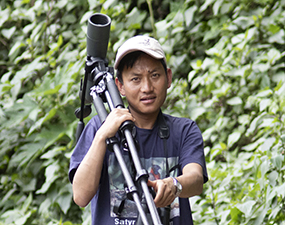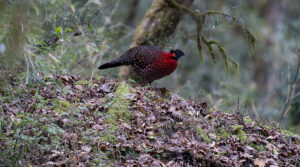
Black-necked Crane Festival




This fall birding tour coincides with the Black-necked Crane festival in Phobjekha valley, Phojekha valley (3000m) with 162sq km area is Bhutan’s largest wetland making it the most favored wintering habitat of the Black-necked Crane in the country. The arrival of cranes in this valley also signals the end of harvesting season and the time for the local communities in Phobjekha to move towards lower altitudes where it is warmer.
The Black-necked Crane commonly known as “ thrung thrung karm” has a sacred identity in Bhutanese culture and is often cited in folklore, dance, and other historical texts. The crane festival annually organized by the local communities in Phobjekha reinforces the importance of cranes in the lives of local people. Historically it is referred to as the heavenly birds because of their beauty and elegance and symbolism of longevity. All in all, we will show you 250 – 270 birds and 10 – 15 species of mammals such as three species of langurs, including the nearly endemic Golden Langur. Himalayan Giant Squirrel, Yellow-throated Marten, and Himalayan Goral,
Other highlights include a visit to Bhutan’s most scenic icon and a most important destination for pilgrimages Taktsang Monastery (Tiger’s Nest), the most beautiful and impressive Punakha Dzong, and attending the Crane Festival with the local community of Phobjekha
Day 1 | Paro: Arrive, Paro, meet our representative. Transfer to the hotel. Afternoon visits to the historic Paro Rimpung Dzong (fortress) and the late afternoon birding along the Paro Chu (River): (Overnight: Paro) |
Day 2 | Paro – Chelila – LocalSightseeing: Very early in the morning, drive to the cool and stunning alpine meadow of Chelila pass (3890m). Drive back to Paro for lunch. After lunch local sightseeing and birding along the Paro Chu (River). Evening visit a typical Bhutanese farmhouse to experience the local hospitality. (Overnight: Paro) |
Day 3 | Paro – Tiger’s Nest – Thimphu: After the breakfast hike Takshang (or the “Tiger’s Nest”) clings to the side of a steep cliff some 200 meters above the Paro valley. Evening drive to Thimphu. (Overnight: Thimphu) |
Day 4 | Thimphu – Punakha: Early morning drive to Punakha over the Dochula Pass (3150). Birding in the Lamperi Botanical Gardens. Drive to Punakha with lunch en route and a visit to the Dzong in the late afternoon. (Overnight: Punakha |
Day 5 | Punakha – Jigme Dorji National Park: we will spend morning birding inside the Jigme Dorji National Park along Mochu Chu River. Afternoon birding along the Pho Chu River and Punatshangchu River. (Overnight: Pun |
Day 6 | Punakha – Phobjikha: Early morning, start driving to the Gangtey Gompa (monastery) to attend the crane festival. After lunch we’ll hike through the Nature trail. (Overnight: Phobjekha) |
Day 7 | Phobjikha – Trongsa: After early breakfast, we’ll drive to the Pelela pass (4000) and spend the morning hours birding along the old road at Pelela. Continue on to Trongsa. Afternoon: Visit the impressive Trongsa Dzong. This Dzong is the ancestral home for the Royal family of Bhutan |
Day 8 | Trongsa – Tingitbe: Today on our drive to Zhemgang, with lots of stops at several-forested valleys en route. This is also our best chance for the Golden Langur, a rare monkey near endemic to Bhutan and only discovered in the 1950s. (Overnight: Tingitbe) |
Day 9 | Tingtibe – Dakphel – Gomphu Road: We’ll explore the entire stretch of Dakphel – Tingtibe road in the morning. Later in the afternoon, we’ll explore the Gomphu road, the road that leads to the Manas National Park. (Overnight: Tingtibe) |
Day 10 | Zhemgang – Bumthang: After our final morning birding in this wonderful habitat we wind up our way to Bumthang, Basically it is transit day and a fairly long drive, we’ll reach to the Bumthang valley. (Overnight: Bumthang) |
Day 11 | Bumthang – Sengor: we drive from Bumthang to Sengor going over Phrumshingla (3800m). Later in the evening, we will be birding around Sengor. (Overnight: Sengor) |
Day 12 | Sengor – Namling – Yongkala: In the morning before we hit our road to Yongkala, we’ll bird around Sengor and Phrumshingla area. Then we will wind up our way to Yongkala en route birding along the forest of Namling and Yongkala. (Overnight: Yongkala) |
Day 13-14 | Yongkala – Namling – Limithang Road: We’ll spend two entire day birding Namling, upper and lower Limithang road, one of the finest birding areas in the Himalayas: (Overnight: Yongkala |
Day 15 | Yongkala – Trashigang: We head toward Trashigang en route birding stop at Kori La, then continue drive to Trashigang. (Overnight: Trashigang |
Day 16 | Trashigang – Morong – Samdrup Jongkhar: After early breakfast in the hotel we head toward Samdrup Jongkhar. Later in the afternoon we’ll be heading to a lower elevation than we have been able to visit so far on the trip. We’ll target the varieties of Low elevation specialties. (Overnight: Samdrup Jongkhar) |
Day 17 | Samdrup Jongkhar – Dewathang – Morong: We will spend the morning exploring the foothills surrounding Samdrup Jongkhar. After lunch we will head further north towards through the forested foothills towards the Morong. The remainder of the afternoon will be spent birding a stretch of mossy, mid-altitude broad-leaved forest. Evening return back to Samdrup Jongkhar. (Overnight: SamdrupJongkhar) |
Day 18 | Samdrup Jongkhar – Guwahati: Today you journey take you through the Indian plain of Assam to Guwahati airport to catch your flight back home |
This birding tour will be on selected sites that do not pose any threats such as steep slopes. During these trips, you should expect yourself to walk at least 6-7 kilometers on average per day
Like elsewhere, the best time for watching birds is in the morning. You can expect an early start in the morning most of the time. However, a couple of very early mornings are required to look for high elevation dwelling Pheasant that comes out to the roadside early in the morning.
Accommodation on this tour is generally simple but comfortable. The hotels are generally spacious, clean, and comfortable, built-in westernized Bhutanese style, and all rooms have private facilities. However, due to the limited availability of good lodges and hotels in some remote parts of the country, you will spend a couple of nights in basic hotels or tented camps.
What is Included?
- • All internal taxes and charges (including SDF)
- • Accommodation on twin sharing basis
- • All meals, tea, snack and bottled water
- • All travel with a licensed local birding guide
- • All surface transfers by a private vehicle
- • Camping equipment and haulage for camping and trekking tours
- • All entry fees to monuments, Museum and National Parks
- • Bhutan Visa Fee
What is not Included?
- • Optional tours/excursions, personal & incidental expenses
- • Tips, laundry, phone calls, and bars
- • International and domestic air fare, and insurance

Sherab Dorji, after completing his high school education, was selected to be an archer for the Bhutan Olympic Committee. As an archer, he traveled to many different countries representing Bhutan in both regional and international competitions. This great opportunity gave him the chance to become very familiar with other cultures.
He occasionally began to take some trips into the wilder areas of Bhutan with Norbu his cousin during his free time as an archer and he started to fall in love with nature. He then decided to quit his profession as an archer and became a full-time birding guide. He was also fortunate to be chosen as one of the several guides to receive special, extensive bird watching training given by well-known American birder Tom Stephenson (Co-Author of The Warbler Guide).
Today, Sherab is one of the top-grade birding guides in the country with many years of guiding experience in guiding international birding clients



